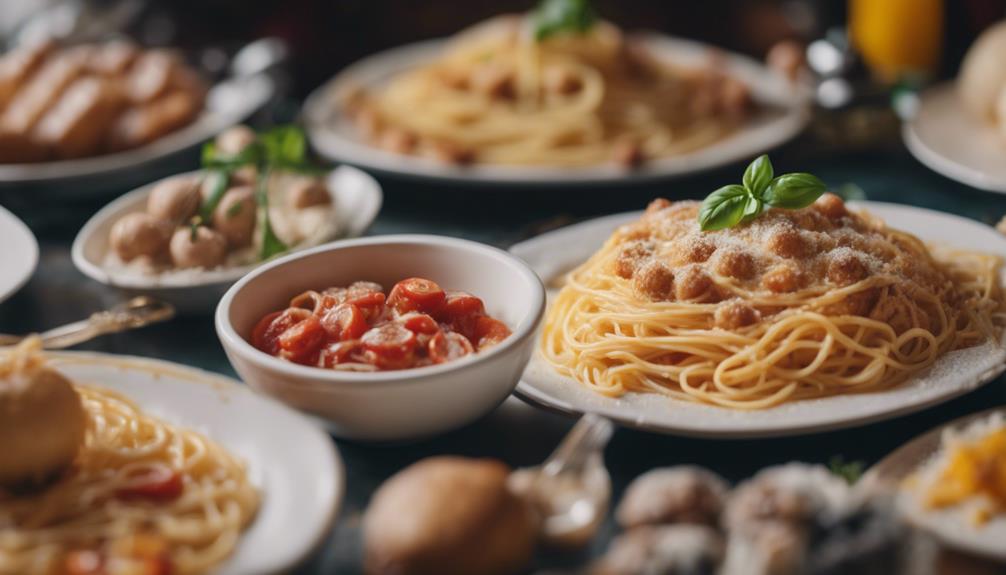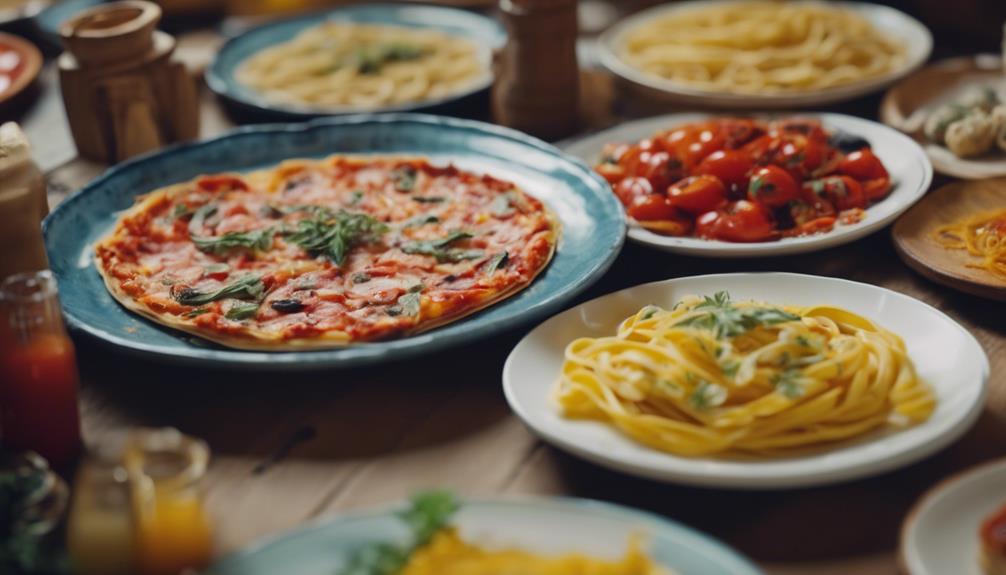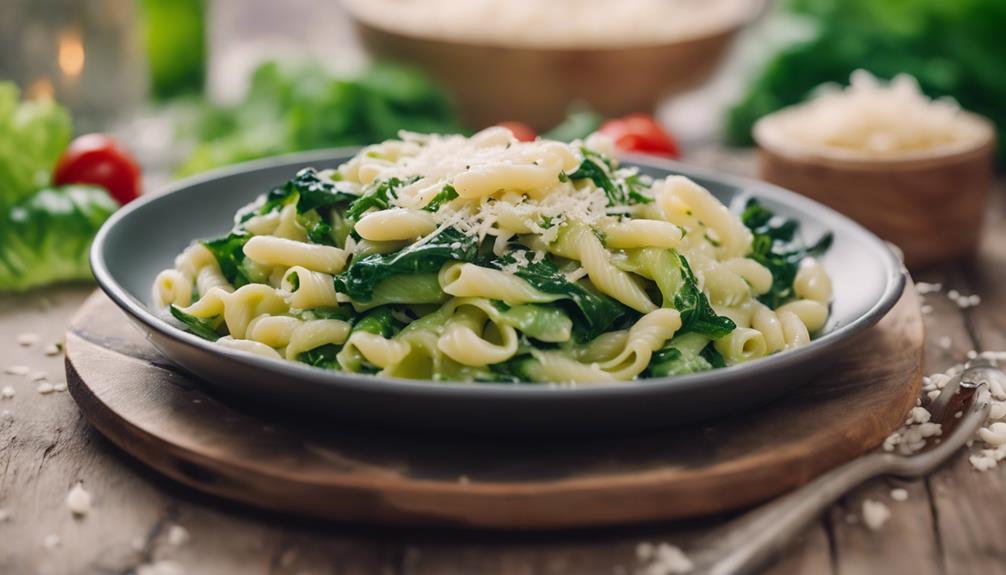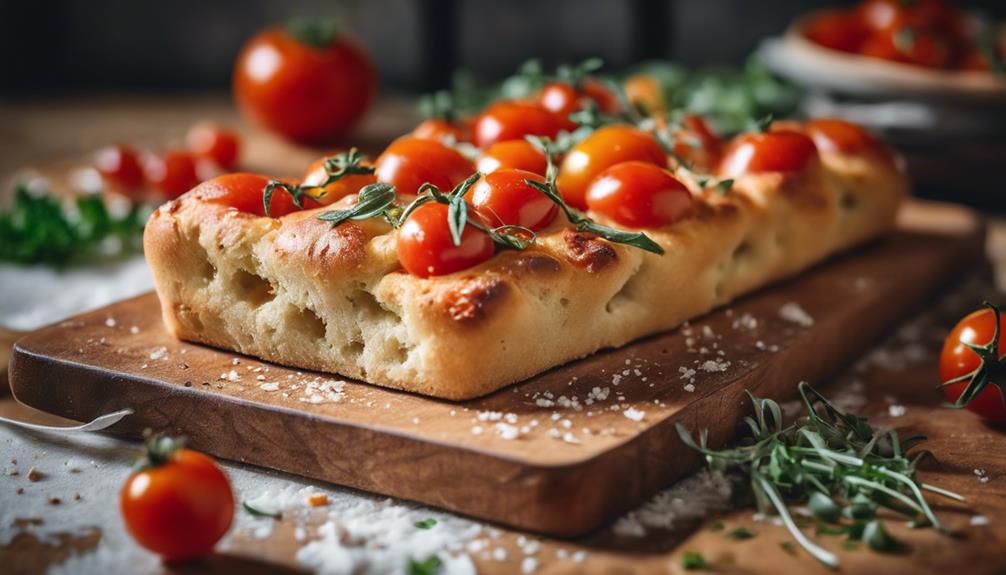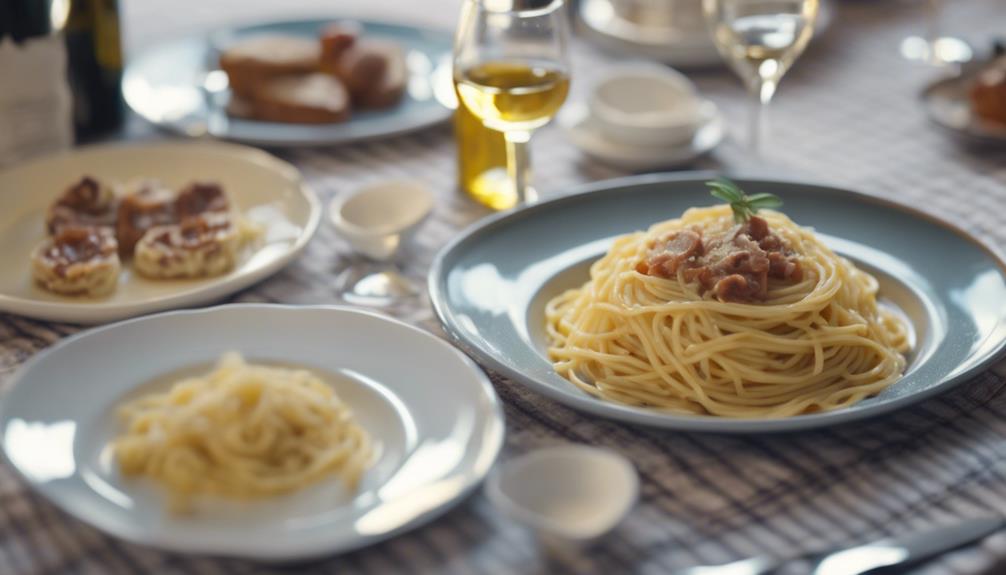Italian cuisine offers a wide variety of popular dishes that will surely please your taste buds. From traditional pasta dishes like Lasagne alla Bolognese to the famous Margherita pizza, Italian food provides a flavorful experience. Treat yourself to delicious desserts such as Tiramisù and Gelato, or enjoy comforting soups like Minestrone. Delve into creamy risotto dishes and tasty antipasti options. Try regional specialties like Venetian Risotto al Nero di Seppia and Sicilian Pasta alla Norma. Italian food is a culinary experience waiting to be explored, offering a blend of flavors and textures that will transport you to the heart of Italy’s lively food scene.
Key Takeaways
- Classic Italian pasta dishes like Lasagne alla Bolognese and Fettuccine al Pomodoro are popular.
- Iconic Italian entrees such as Gnocchi di Patate and Melanzane alla Parmigiana are well-loved.
- Traditional Italian pizzas like Margherita and regional specialties are widely enjoyed.
- Decadent Italian desserts like Tiramisù and Cannoli are popular choices.
- Hearty Italian soups like Minestrone and Seafood Gnocchi soup are favored dishes.
Classic Pasta Dishes
Discover the timeless appeal of classic pasta dishes in Italian cuisine. Pasta, a staple in Italian cooking, is often paired with rich and flavorful sauces that vary from region to region.
One iconic pasta dish is Lasagne alla Bolognese, featuring layers of pasta with a hearty beef, tomato, and onion bolognese sauce — a true taste of Bologna, Italy.
Another favorite is Fettuccine al Pomodoro, where the simplicity of a light tomato and basil sauce perfectly complements the pasta, creating a burst of traditional Italian flavors in every bite.
Gnocchi di Patate, a popular alternative to traditional pasta, is handmade by grandmothers across Italy and pairs deliciously with various sauces.
Olive oil, a key ingredient in many Italian dishes, adds a rich and smooth texture to pasta sauces, enhancing the overall taste.
Whether it's the classic tomato sauce or a more complex olive oil-infused creation, Italian cuisine offers a wide array of delectable pasta dishes to satisfy your cravings.
Iconic Italian Entrees

Indulge in the timeless flavors and traditions of iconic Italian entrees that will transport your taste buds to the heart of Italy. From the famous Lasagne alla Bolognese, with its rich beef, tomato, and onion sauce originating from Bologna, to the classic Fettuccine al Pomodoro, a light dish with a delightful tomato and basil sauce, Italian cuisine never fails to impress.
If you're looking for a unique twist, try the Gnocchi di Patate, a popular alternative to pasta traditionally enjoyed at lunch in central Italy. These soft potato dumplings offer exciting flavors that will leave you craving more.
On colder evenings, savor the Melanzane alla Parmigiana, a traditional Italian dish made with thinly sliced aubergine, baked to perfection, and topped with cheese.
For a heartwarming meal, the Pollo alla Cacciatora is a classic chicken stew seasoned with olive oil, tomatoes, and red wine. This dish is bursting with traditional Italian ingredients that will satisfy your cravings and warm your soul.
Traditional Pizza Varieties
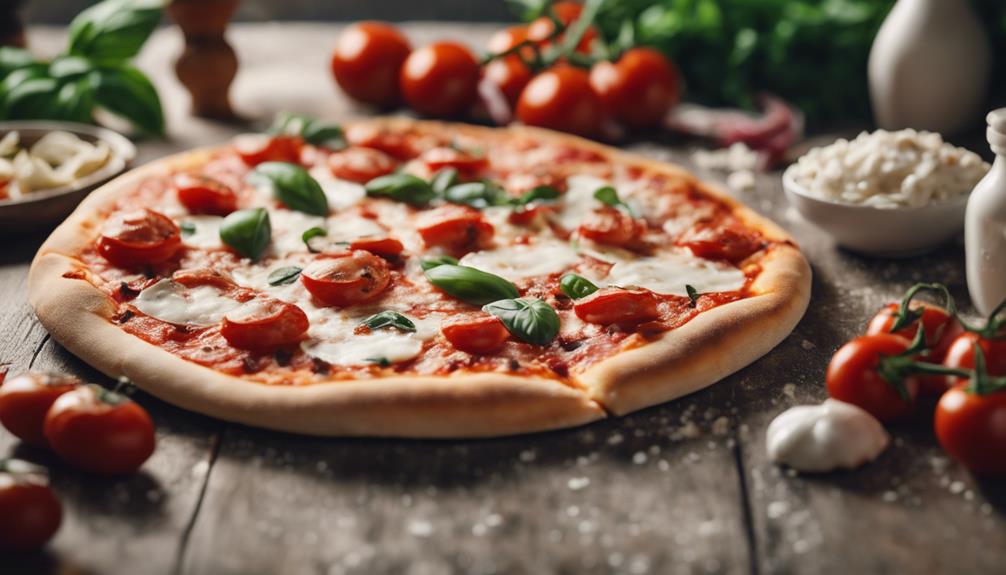
Let's talk pizza!
From the classic Margherita pizza to regional pizza specialties, Italy boasts a wide array of delicious pie options to satisfy every craving.
Get ready to explore the diverse and mouthwatering world of traditional Italian pizza varieties!
Classic Margherita Pizza
One of the most iconic traditional pizza varieties is the classic Margherita pizza, celebrated for its simplicity and timeless flavors. Originating in Naples in the 18th century, this Italian pizza has gained worldwide fame and even received UNESCO recognition as Intangible Cultural Heritage.
The Margherita pizza charms pizza lovers with its traditional flavors of tomato sauce, mozzarella cheese, and fresh basil, all delicately placed on a thin crust. What makes this pizza stand out is its minimalistic toppings, allowing the quality of each ingredient to shine through.
Each pizzeria has its secret recipe for crafting the perfect Margherita pizza, making each one a unique experience. Whether it's the way the cheese melts or the freshness of the basil, every bite tells a story of tradition and craftsmanship.
This classic pizza serves as an easy introduction to the world of traditional Italian pizza, with its basic yet delicious components that capture the essence of Italian cuisine.
Regional Pizza Specialties
Explore the diverse world of traditional Italian pizza varieties, each showcasing unique regional flavors and styles. From the iconic Neapolitan pizza to the hearty Sicilian pizza, regional Italian pizzas offer a delicious glimpse into Italy's culinary heritage. Check out the table below to discover more about these mouthwatering pizza specialties:
| Pizza Variety | Origin | Key Features |
|---|---|---|
| Neapolitan pizza | Naples | Thin, soft crust with San Marzano tomatoes |
| Roman pizza | Rome | Thin and crispy crust with minimal toppings |
| Sicilian pizza | Sicily | Thick, rectangular crust with generous toppings |
| Margherita pizza | Naples | Simple yet flavorful with basil and fresh mozzarella |
| Napoletana pizza | Southern Italy | Seafood toppings like anchovies and shrimp |
Each pizza variety reflects the diverse culinary traditions found throughout Italy. Whether you prefer the simplicity of a Margherita or the bold flavors of a Sicilian, regional Italian pizzas are sure to tantalize your taste buds. Delve into a slice of Italy today!
Decadent Italian Desserts

Indulging in decadent Italian desserts is a delightful way to satisfy your sweet cravings while experiencing the rich culinary tradition of Italy. From the velvety layers of Tiramisù to the silky smoothness of Pannacotta, Italian desserts offer a symphony of flavors and textures that will tantalize your taste buds.
Gelato, Italy's famous frozen treat, is a must-try for anyone with a sweet tooth. Its dense and creamy texture, along with flavors like pistachio and stracciatella, will transport you to the bustling streets of Rome.
For those craving something crispy and sweet, Cannoli, the beloved Sicilian pastry filled with ricotta cheese and sprinkled with pistachios, is a delightful choice.
If you're a coffee lover, don't miss out on the Affogato, a simple yet elegant dessert where a shot of hot espresso is poured over a scoop of vanilla gelato, creating a delicious contrast of temperatures and flavors.
Italian desserts aren't just treats; they're experiences that will leave you craving for more.
Hearty Italian Soups

Italian soups, with their hearty and comforting flavors, are a staple in the rich culinary tradition of Italy. When it comes to Italian soups, Minestrone stands out as a classic choice. This vegetable-packed soup offers a delightful mix of seasonal veggies simmered in a flavorful broth, perfect for warming you up on a chilly day.
If you're in the mood for something a bit more indulgent, Seafood Gnocchi soup might be just what you need. The combination of soft gnocchi and a savory seafood broth filled with shrimp and mussels creates a dish that's both luxurious and satisfying.
Don't forget to pair your soup with a side of Focaccia, the traditional Italian flatbread that adds a delicious touch to your meal.
And for those looking for a creamy alternative, Risotto can also double as a comforting soup. Whether you opt for a classic mushroom risotto or try a different variation, the rich and creamy texture is sure to please your taste buds.
Rich Risotto Creations
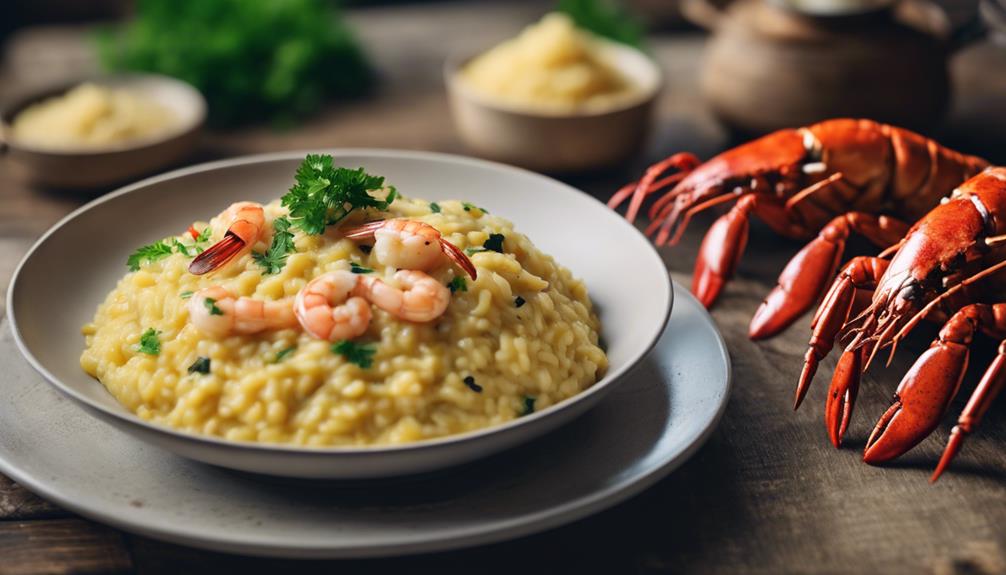
Discover the diverse and decadent world of rich risotto creations, showcasing a variety of flavors and ingredients in each creamy mouthful. Risotto, a beloved Italian food, hails mainly from the northern regions of Italy. Its creamy texture is achieved through the slow cooking process, where warm broth is gradually added to the rice, allowing it to absorb the liquid and release starch. This technique results in a comforting dish with a luxurious consistency that can be tailored to suit various tastes.
Italian regions offer an array of risotto varieties, each with its unique twist. From the traditional Risotto alla Milanese to the flavorful Italian Wedding Risotto and the hearty Beef Brasato with Pappardelle and Mint, there's a risotto for every palate.
This Italian comfort food not only delights the senses but also serves as a canvas for creativity in the kitchen. So, whether you prefer seafood, meats, cheeses, or vegetables, risotto is a versatile dish that never fails to satisfy.
Flavorful Antipasti Options

Exploring a variety of flavorful antipasti options reveals the vibrant and diverse world of traditional Italian starters. Antipasti, the quintessential Italian appetizers, offer a delightful array of cured meats, cheeses, olives, marinated vegetables, and more.
Imagine this: a plate adorned with thinly sliced prosciutto, a delicate balance of salty and savory; crispy bruschetta topped with fresh tomatoes, basil, and garlic; and a revitalizing caprese salad with layers of ripe tomatoes, creamy mozzarella, and fragrant basil leaves. These tantalizing bites aren't just delicious but also play an essential role in Italian dining culture – stimulating your palate and setting the stage for the main course.
As you immerse yourself in the world of antipasti, you'll encounter an explosion of flavors and textures, each bite telling a story of Italy's culinary heritage.
Regional Italian Specialties
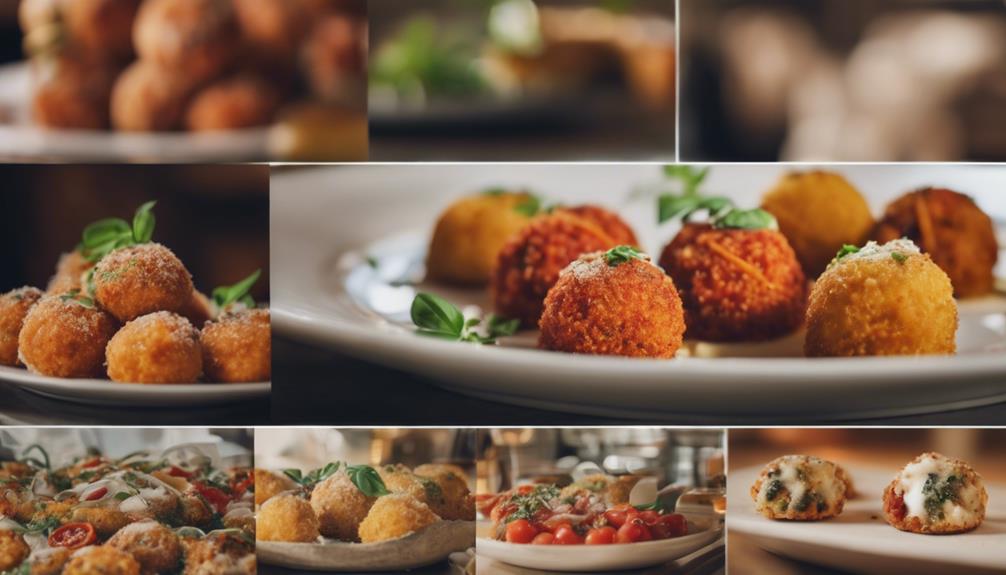
Immerse yourself in the culinary tapestry of Italy's diverse regions by delving into the array of regional Italian specialties. These dishes reflect the unique flavors and traditions of each area, offering a delightful journey for your taste buds. Let's explore some quintessential regional Italian specialties:
| Northern Italy | Southern Italy |
|---|---|
| Venetian Risotto al Nero di Seppia | Sicilian Pasta alla Norma |
| Ligurian Pesto Genovese | Neapolitan Pizza Margherita |
| Tuscan Ribollita | Roman Cacio e Pepe |
From the rich and creamy Venetian Risotto al Nero di Seppia to the flavorful Sicilian Pasta alla Norma, each dish tells a story of its region. The aromatic Ligurian Pesto Genovese, the hearty Tuscan Ribollita, the classic Roman Cacio e Pepe, and the iconic Neapolitan Pizza Margherita are all must-try specialties that capture the essence of Italy's diverse culinary landscape. So, grab a fork and indulge in these regional delights that will transport you to the heart of Italy's gastronomic heritage. Buon appetito!
Frequently Asked Questions
What Are the Top 10 Italian Dishes?
To learn about the top 10 Italian dishes, explore a rich culinary heritage. From Pasta Carbonara to Tiramisu, experience the joy of Italian cuisine. Indulge in Bruschetta, Cannoli, and more for a flavorful journey.
What Are 5 Traditional Italian Dishes?
You should explore traditional Italian dishes. From lasagne alla Bolognese to chicken cacciatora, these classics offer rich flavors and cultural heritage. Try fettuccine al pomodoro or gnocchi di patate for a taste of Italy's diverse cuisine.
What Is Italy's Most Popular Dishes?
When in Italy, try iconic dishes like Pizza Margherita, Pasta Carbonara, Tiramisu, Risotto, and Gelato. These beloved classics showcase Italy's rich culinary heritage and are sure to delight your taste buds with every bite.
What Are 3 Famous Foods From Italy?
When it comes to Italy's famous dishes, you can't go wrong with classics like Pizza Margherita, Lasagne alla Bolognese, and Tiramisù. These iconic foods represent the rich culinary heritage of Italy and are beloved worldwide.
What Italian Dishes are Offered at Officina del Gusto Lastra a Signa?
Officina del Gusto in Lastra a Signa offers a delectable variety of Italian delicacies at Officina del Gusto. From homemade pasta dishes like spaghetti carbonara and rigatoni alla amatriciana to savory mains like osso buco and tiramisu for dessert, it’s a culinary journey through Italy’s flavors.
Conclusion
To sum up, Italian cuisine offers a delightful array of dishes that cater to every palate.
Did you know that pasta is the most popular Italian dish worldwide, with an average Italian consuming over 23 kilograms of pasta annually?
So next time you're craving some delicious Italian food, remember that you're not alone in your love for pasta! Buon appetito!
